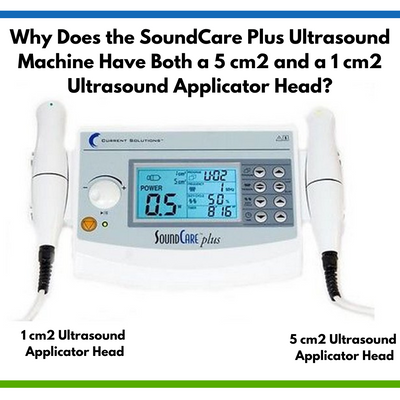 11th Sep 2024
11th Sep 2024
Why Does the SoundCare Plus Ultrasound Machine Have Both a 5 cm2 and a 1 cm2 Ultrasound Applicator Head?
In the treatment of musculoskeletal injuries and conditions, there are a wide variety of conditions as well as significant differences in the size of a targeted treatment area. The use of ultrasound is a standard therapy in the treatment of many musculoskeletal injuries and conditions. The ability to focus the ultrasound treatment to maximize its effectiveness and reduce total required treatment time are important factors that a therapist considers in treating their patient and in running their clinic. There are a few key factors, relevant to the topic of this article, that will impact the effectiveness of the treatment and the required duration of the treatment. They are:
1. Size of the Area to be Treated . Ultrasound therapy treatment should be limited to an area that is no more than two to three times the size of the effective radiating area (ERA) of the crystal in the soundhead , or twice the size of the soundhead surface. If an area to be treated is, for example, two inches in length and about one inch in width, it could not be effectively covered using a 1 cm2 soundhead but would require a 5 cm2 soundhead. Further, if the area to be treated was much smaller, for example, the temporomandibular joint area, a 1 cm sound head would effectively cover the targeted area.
- Note: For targeted treatment of various musculoskeletal conditions, having both a 5 cm2 and a 1 cm2 soundhead on the same machine where the practitioner can manually switch between the two applicator soundheads with the touch of a single button ensures that any musculoskeletal condition can be effectively treated.
2. Keeping the Soundhead in Flush Contact with the Body Surface Being Treated . For the soundwave to be effectively transmitted from the soundhead, through the gel medium, and into the body tissues, it must be kept in flush contact with the body surface being treated at all times. Research has shown that lifting or tilting the soundhead at an angle of even 15 degrees will result in a significant reflection loss of energy and reduction in the efficacy of the treatment.
- Note: Consider that you are treating the condition of lateral epicondylitis (Tennis Elbow) where the wrist extensor muscle’s tendonous origin attachment to the lateral epicondyle of the elbow area are inflamed. This is a very bony prominent area where it would be impossible to keep a 5 cm2 soundhead flush with the treatment surface. A 1 cm2 soundhead would be required to effectively administer the therapy as a 5 cm2 soundhead would repeatedly be tilted and lose surface-to-surface contact with the anatomical structure of this area.
The SoundCare Plus Ultrasound Machine with both a 1 cm2 and a 5 cm2 soundhead applicator, enables you to treat a larger area, for example, a large muscle or deeper tissue, while a 1 cm2 ultrasound head is better for smaller, more superficial areas like the TMJ, hands, feet, etc. Below are some examples of where the different soundhead sizes would be better used to provide for a more effective treatment.
Musculoskeletal Conditions Best Treated with a 1 cm2 Soundhead | | | Musculoskeletal Conditions Best Treated with a 5 cm2 Soundhead |
TMJ Dysfunction Sprains of the finger & toe joints Medial or Lateral Epicondylitis Achilles Tendinitis Ulnar Nerve Entrapment Trigger Points | Piriformis Syndrome Carpal Tunnel Syndrome Muscle or muscle group strains Muscle spasms Low back muscle and/or fascial injury Plantar fasciitis |
We invite you to discover the extensive information found on the SoundCare Plus Ultrasound Machine “product page” to learn more about this top quality clinical grade ultrasound device by Roscoe Medical. From the product page you can also access:
- SoundCare Plus Ultrasound Machine User’s Manual
- An extensive PowerPoint of ultrasound therapy titled, “Therapeutic Ultrasound – A Compliment to Musculoskeletal Rehabilitation”





